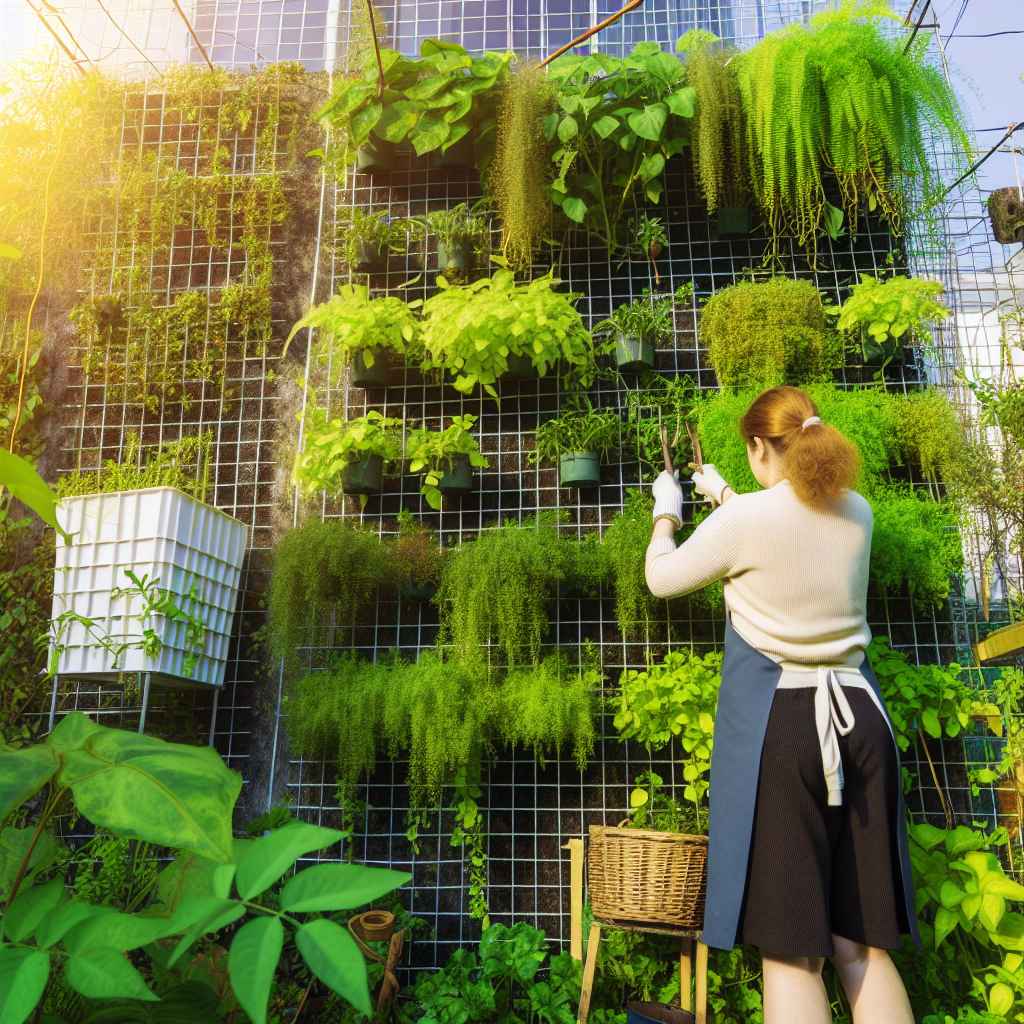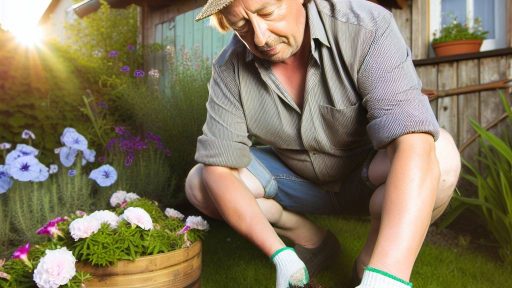Introduction to Indoor Gardening and Vertical Farming
Indoor gardening brings nature inside our homes.
It allows anyone to grow plants, even in small spaces.
This practice promotes well-being and environmental awareness.
Vertical farming takes this concept further.
With vertical farming, you can maximize space efficiency.
This method uses vertical structures to grow plants upward.
It is particularly effective in urban settings.
People can grow a variety of plants indoors.
Herbs, leafy greens, and even small fruits thrive in these setups.
Moreover, vertical farming can be sustainable and resource-efficient.
It reduces water usage compared to traditional gardening methods.
Additionally, it minimizes the need for chemical fertilizers.
Indoor gardening and vertical farming address food security issues.
They provide fresh produce year-round, regardless of climate.
Homegrown plants also taste better than store-bought options.
Transform Your Agribusiness
Unlock your farm's potential with expert advice tailored to your needs. Get actionable steps that drive real results.
Get StartedThus, embracing these methods can lead to healthier lifestyles.
Let’s explore some creative ideas for utilizing vertical farming in our homes.
Benefits of Vertical Farming in Small Spaces
Optimizes Space Usage
Vertical farming makes efficient use of limited space.
It allows for more plants to be grown in a smaller footprint.
This technique maximizes the number of crops per square foot.
Moreover, it transforms even the smallest areas into productive gardens.
Improves Air Quality
Indoor plants in vertical gardens help purify the air.
They filter pollutants and emit oxygen, enhancing indoor environments.
Additionally, this contributes to a healthier living space.
Consequently, it improves your overall well-being.
Reduces Water Usage
Vertical farming often requires less water than traditional methods.
Drip irrigation systems are commonly used to conserve water.
These systems deliver water directly to the plant roots.
As a result, water waste is minimized in these setups.
Promotes Year-Round Gardening
With indoor vertical gardens, you can grow crops throughout the year.
This eliminates seasonal restrictions on plant growth.
Grow lights can provide the necessary light, regardless of external conditions.
Therefore, you can enjoy fresh produce in every season.
Enhances Aesthetic Appeal
Vertical gardens add visual interest to indoor spaces.
They serve as living artwork that beautifies homes or offices.
Moreover, lush greenery can have a calming effect on the mind.
As a bonus, they create a more inviting atmosphere.
Choosing the Right Plants for Indoor Vertical Gardens
Consider Your Space
Assess your available vertical space carefully.
Different plants require varying amounts of room to grow.
Showcase Your Farming Business
Publish your professional farming services profile on our blog for a one-time fee of $200 and reach a dedicated audience of farmers and agribusiness owners.
Publish Your ProfileDetermine how much light your location receives.
Know if you want plants for decoration, food, or both.
Factors to Consider
Choose plants based on growth habits and sizes.
Look for varieties that thrive in compact spaces.
Understand the light and water requirements of each plant.
Some plants may need more humidity than others.
Popular Plant Choices
- Herbs like basil and parsley grow well indoors.
- Leafy greens like lettuce and spinach do not need much height.
- Small fruiting plants such as strawberries fit nicely.
- Succulents are perfect for low-maintenance options.
- Ferns can add a lush touch to your vertical garden.
Creative Planting Ideas
Try incorporating hanging pots for an artistic look.
Use wall-mounted planters to maximize your area.
Consider a tiered shelving system for additional layers.
Incorporating a trellis can provide support for climbing plants.
Maintaining Your Indoor Vertical Garden
Regularly check for pests and diseases on your plants.
Ensure each plant receives appropriate water and nutrients.
Rotate plants for even exposure to light.
Regular pruning will help to keep plants healthy and tidy.
Explore Further: How to Choose the Right Seeds for High-Yield Microgreens Farming
Essential Tools and Materials for Vertical Gardening
Identifying Key Tools
Gathering the right tools is crucial for vertical gardening.
A high-quality set of pruning shears helps maintain your plants.
A sturdy trowel assists with planting and transferring soil.
A watering can allows for efficient watering of your vertical garden.
Lastly, a level ensures your structures are straight and even.
Choosing the Right Containers
Containers play a pivotal role in vertical gardening.
Opt for hanging pots to maximize vertical space.
Stackable planters can also save valuable floor area.
Additionally, wall-mounted planters can create stunning displays.
Consider using self-watering containers for lower maintenance.
Selecting Suitable Soil and Nutrients
The right soil is foundational for healthy plants.
A lightweight potting mix works best for vertical setups.
Incorporate organic fertilizers for nutrient-rich soil.
Make sure to adjust nutrients based on plant types.
Testing soil pH can also guide your choices.
Essential Support Structures
Support structures provide needed stability for vertical gardening.
Use trellises to train climbing plants vertically.
Vertical grids or netting offer support for additional vining plants.
Consider repurposing pallets for an eco-friendly solution.
Metal racks can also provide durability and an appealing design.
Learn More: Seasonal Gardening for Drought-Resistant Crops
Creative Vertical Gardening Structures and DIY Ideas
Using Wall Planters
Wall planters maximize vertical space effectively.
They come in various designs and sizes.
You can hang them on walls to create a stunning display.
Moreover, they work well in small apartments or homes.
Showcase Your Farming Business
Publish your professional farming services profile on our blog for a one-time fee of $200 and reach a dedicated audience of farmers and agribusiness owners.
Publish Your ProfileBuilding a Vertical Garden Frame
A vertical garden frame is an excellent structured solution.
Use wood pallets or pegboards as bases.
Fill the frame with planted pots or small planters.
This method allows you to grow various herbs and flowers.
Repurposing Old Furniture
Old furniture can be transformed into unique garden structures.
Consider using a ladder or bookshelf for vertical gardening.
Align pots on each step or shelf to use space creatively.
This adds character while providing ample growing space.
Employing Hanging Planters
Hanging planters save space without sacrificing style.
Consider using macramé hangers for a boho touch.
Additionally, utilize ceiling hooks to suspend plants.
This technique works great for trailing plants that grow downwards.
Creating a Living Wall
A living wall showcases plants beautifully indoors.
Employ pocket planters or modules for better arrangement.
Be sure to select plants with similar care needs.
It adds greenery and purifies the air inside your home.
Vertical Hydroponic Systems
Hydroponic systems utilize vertical spaces sustainably.
They can produce vegetables in limited areas efficiently.
Many kits are available specifically for indoor use.
Moreover, hydroponics reduces water usage significantly.
DIY Trellis for Climbing Plants
Creating a trellis is a fun and effective DIY project.
Use PVC pipes, wood, or bamboo for construction.
This option works great for supporting vines or other plants.
Additionally, it adds height and dimension to your garden.
Learn More: DIY Garden Projects for Greenhouse Farming
Lighting Considerations for Indoor Vertical Farms
Importance of Adequate Lighting
Proper lighting is crucial for indoor vertical farming.
Plants need light for photosynthesis and growth.
Inadequate lighting can hinder your plants’ health.
Thus, investing in a good lighting system is essential.
Types of Grow Lights
Several types of grow lights are available for indoor gardens.
LED lights are energy-efficient and long-lasting.
Fluorescent lights offer a broad spectrum, ideal for seedlings.
Halide lights provide intense illumination but consume more energy.
Choosing the right type directly influences plant growth.
Light Spectrum and Plant Needs
Plants require specific light wavelengths for optimal growth.
Blue light promotes leaf growth and strong stems.
Red light encourages flowering and fruiting in plants.
A full-spectrum light mimics natural sunlight.
Hence, it’s advisable to use full-spectrum grow lights.
Light Duration and Intensity
Different plants have distinct light duration needs.
Showcase Your Farming Business
Publish your professional farming services profile on our blog for a one-time fee of $200 and reach a dedicated audience of farmers and agribusiness owners.
Publish Your ProfileMost plants thrive with 12 to 16 hours of light daily.
Monitor the light’s intensity based on plant types.
Adjusting the distance between lights and plants is important.
Always observe plant responses to lighting changes.
Energy Efficiency and Sustainability
Energy-efficient lights help reduce electricity costs.
Consider using timers to manage light schedules.
Additionally, employing reflective materials enhances light distribution.
This approach maximizes the benefits of your grow lights.
Gain More Insights: Sustainable Agroforestry Practices for Small-Scale Farmers

Soil and Nutrient Management in Vertical Gardens
Understanding Soil Composition
Sole composition plays a crucial role in vertical gardening.
It impacts moisture retention and nutrient availability.
A balanced soil mix promotes healthy plant growth.
Start with a quality potting mix designed for containers.
Adding organic compost enhances soil structure.
Choosing the Right Nutrients
Nutrients are vital for plant health in vertical gardens.
Key nutrients include nitrogen, phosphorus, and potassium.
Fertilizers can replenish nutrient levels regularly.
Consider using slow-release fertilizers for convenience.
Implementing Fertilization Techniques
Fertilization techniques vary for vertical gardens.
Foliar feeding provides quick nutrient absorption.
Drip irrigation systems can also nourish plants effectively.
Plan your fertilization schedule according to plant needs.
Monitoring Soil Health
Regularly check soil health to ensure optimal growth.
Use soil testing kits to analyze nutrient levels.
pH levels should also be monitored for balance.
Adjust soil composition based on testing results.
Water Management Strategies
Water is essential in vertical gardening.
Consider drip irrigation to minimize water waste.
Ensure proper drainage to prevent root rot.
Mulching can help retain moisture in the soil.
Watering Systems for Efficient Vertical Gardening
Importance of Efficient Watering
Efficient watering is essential for vertical gardening success.
It conserves water and promotes healthy plant growth.
Moreover, precise watering prevents overwatering and root rot.
Types of Watering Systems
Selecting the right watering system is crucial for vertical gardens.
Several effective methods exist to maintain optimal moisture levels.
- Drip Irrigation
- Hydroponics
- Wicking Beds
- Self-Watering Planters
Drip Irrigation
Drip irrigation delivers water directly to the plant roots.
This method minimizes water wastage and maximizes efficiency.
Additionally, it reduces the risk of diseases by avoiding wet foliage.
Hydroponics
Hydroponics relies on a nutrient-rich water solution.
This system eliminates soil, allowing for more space-saving vertical designs.
Showcase Your Farming Business
Publish your professional farming services profile on our blog for a one-time fee of $200 and reach a dedicated audience of farmers and agribusiness owners.
Publish Your ProfileFurthermore, it delivers nutrients directly to the roots for faster growth.
Wicking Beds
Wicking beds use a unique self-watering system.
They draw moisture up through the soil from a water reservoir.
This method ensures consistent moisture without frequent watering.
Self-Watering Planters
Self-watering planters have a built-in reservoir at the bottom.
They provide plants with access to water as needed.
This system allows for less maintenance while ensuring healthy plants.
Considerations for Choosing a System
When choosing a watering system, consider several factors.
Assess the size of your vertical garden and the types of plants.
Evaluate your available space and budget before making a decision.
Pest Management and Plant Care in Indoor Vertical Spaces
Importance of Pest Management
Effective pest management is crucial for healthy indoor gardens.
Pests can quickly damage plants and reduce yield.
Additionally, early detection prevents major infestations.
Common Indoor Pests
Several pests frequently affect indoor gardens.
- Aphids are small, sap-sucking insects.
- Spider mites thrive in dry conditions.
- Mealybugs appear as white, cottony clusters.
- Fungus gnats are pesky, small flying insects.
Preventive Measures
Preventing pest problems is an essential strategy.
Start by ensuring good air circulation around plants.
Regularly inspect your plants for early signs of infestations.
Clean your gardening tools and surfaces frequently.
Natural Pest Control Methods
Natural methods can help manage pests effectively.
Introduce beneficial insects, like ladybugs or lacewings.
Use neem oil as a natural pesticide.
Incorporate insecticidal soap for direct pest control.
Optimal Plant Care Tips
Proper plant care enhances resilience against pests.
Ensure plants receive adequate light and water.
Maintain soil health with organic nutrients.
Monitoring Plant Health
Consistent monitoring plays a key role in plant care.
Observe leaf color and texture for distress signs.
Adjust care routines based on environmental changes.
Regular Maintenance Practices
Regular maintenance is vital for thriving indoor gardens.
- Prune dead or yellowing leaves promptly.
- Rotate plants to ensure even light exposure.
- Repot plants as they outgrow their containers.
Using Technology for Plant Care
Embrace technology to simplify plant care routines.
Smart sensors can monitor light and moisture levels.
Use apps to track growth and pest management.
Automated systems can help with watering schedules.
Showcasing Successful Indoor Vertical Farming Examples
Urban Garden Project in Brooklyn
This innovative project uses small indoor spaces effectively.
It features vertical planters for herbs and leafy greens.
Residents enjoy fresh produce year-round despite limited space.
The project also fosters community engagement and education.
Hydroponic Vertical Farm in San Francisco
This farm utilizes hydroponic technology to grow various vegetables.
It operates in a repurposed warehouse, maximizing space efficiently.
Organic produce is sold directly to local restaurants and markets.
Showcase Your Farming Business
Publish your professional farming services profile on our blog for a one-time fee of $200 and reach a dedicated audience of farmers and agribusiness owners.
Publish Your ProfileThe farm boasts sustainability through water conservation techniques.
Home-Based Vertical Garden Solutions
Individuals can transform even a small apartment with vertical gardens.
Wall-mounted planters allow for a variety of plants in compact areas.
A popular option is using vertical racks for herb gardening.
This method enhances air quality and adds beauty to indoor spaces.
Commercial Vertical Farming Innovations
Companies like AeroFarms lead the way in commercial vertical farming.
Their facilities employ LED lighting to optimize plant growth.
These farms produce food with minimal environmental impact.
They serve urban areas, reducing transportation costs and emissions.
Schools and Educational Institutes Implementing Vertical Gardens
Schools across the country are adding vertical gardens to their curricula.
Students learn about agriculture, sustainability, and nutrition.
These projects provide hands-on experience and foster responsibility.
Moreover, they encourage healthy eating habits among children.
Additional Resources
How to Grow More Cut Flowers than You Ever Thought Possible …
Center for Urban Agriculture & Gardening Education | College of …




